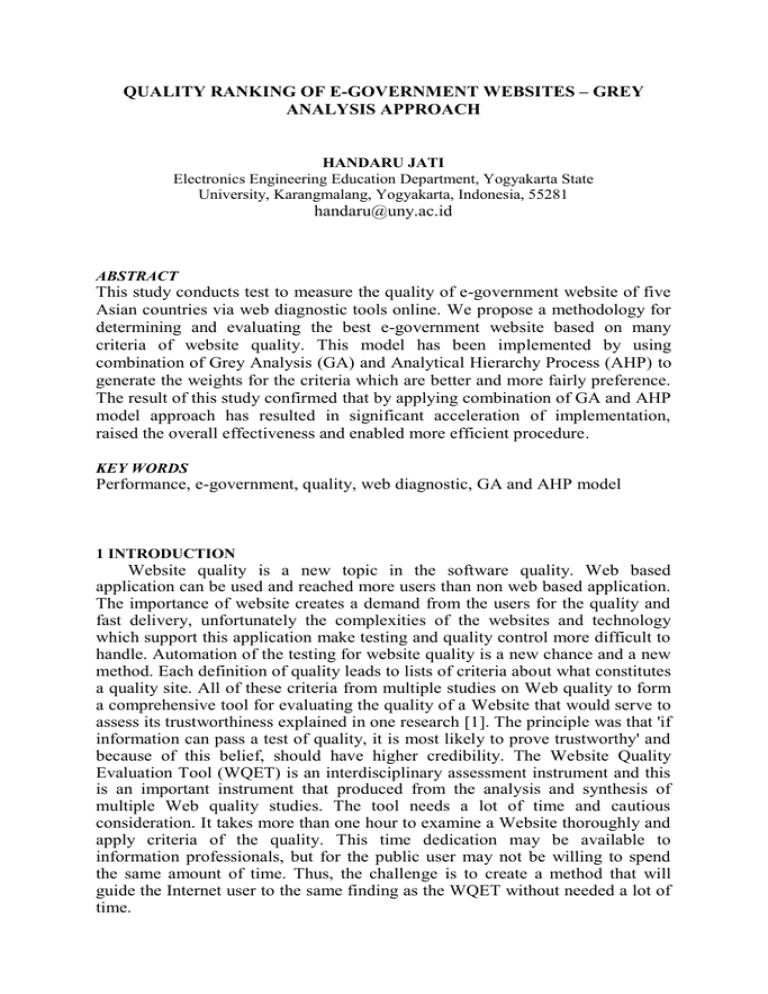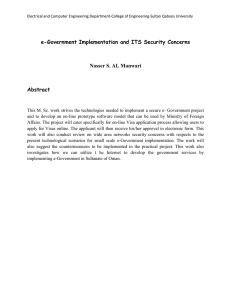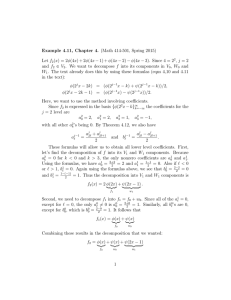QUALITY RANKING OF E-GOVERNMENT WEBSITES – GREY ANALYSIS APPROACH
advertisement

QUALITY RANKING OF E-GOVERNMENT WEBSITES – GREY ANALYSIS APPROACH HANDARU JATI Electronics Engineering Education Department, Yogyakarta State University, Karangmalang, Yogyakarta, Indonesia, 55281 handaru@uny.ac.id ABSTRACT This study conducts test to measure the quality of e-government website of five Asian countries via web diagnostic tools online. We propose a methodology for determining and evaluating the best e-government website based on many criteria of website quality. This model has been implemented by using combination of Grey Analysis (GA) and Analytical Hierarchy Process (AHP) to generate the weights for the criteria which are better and more fairly preference. The result of this study confirmed that by applying combination of GA and AHP model approach has resulted in significant acceleration of implementation, raised the overall effectiveness and enabled more efficient procedure. KEY WORDS Performance, e-government, quality, web diagnostic, GA and AHP model 1 INTRODUCTION Website quality is a new topic in the software quality. Web based application can be used and reached more users than non web based application. The importance of website creates a demand from the users for the quality and fast delivery, unfortunately the complexities of the websites and technology which support this application make testing and quality control more difficult to handle. Automation of the testing for website quality is a new chance and a new method. Each definition of quality leads to lists of criteria about what constitutes a quality site. All of these criteria from multiple studies on Web quality to form a comprehensive tool for evaluating the quality of a Website that would serve to assess its trustworthiness explained in one research [1]. The principle was that 'if information can pass a test of quality, it is most likely to prove trustworthy' and because of this belief, should have higher credibility. The Website Quality Evaluation Tool (WQET) is an interdisciplinary assessment instrument and this is an important instrument that produced from the analysis and synthesis of multiple Web quality studies. The tool needs a lot of time and cautious consideration. It takes more than one hour to examine a Website thoroughly and apply criteria of the quality. This time dedication may be available to information professionals, but for the public user may not be willing to spend the same amount of time. Thus, the challenge is to create a method that will guide the Internet user to the same finding as the WQET without needed a lot of time. There are many scope of quality, and each measure will pertain to a particular website in varying degrees. Here are some of them: first factor is time, a credible site should be updated frequently. The information about latest update also should be included on the homepage. However, if the information has not been updated currently, the visitor could easily know that perhaps the site manager does really bother to update the site. Second factor is structural, all of the parts of the website hold together and all links inside and outside the website should work well. Broken links on the webpage also are another factor that always downgrades the quality of website. Each page usually has references or links or connections to other pages. These may be internal or external web site. Users expect each link to be valid, meaning that it leads successfully to the intended page or other resource. In the year of 2003, discovered that about one link out of every 200 disappeared each week from the Internet [2]. The third factor is content; number of the links, or link popularity is one of the off page factors that search engines are looking to determine the value of the webpage. Most of search engine will need a website to have at least two links pointing to their site before they will place it to their index, and the idea of this link popularity is that to increase the link popularity of a website, this website must have large amount of high quality content. Number of links to website improves access growth and helps to generate traffic [3]. Search engine such as Google make a citation analysis to rank hits, then a website which has a many links to it will have a higher ranking compared a website with few links. This indicator can be used to measure the quality of web site. Fourth factor is response time and latency; a website server should respond to a browser request within certain parameters, it is found that extraneous content exists on the majority of popular pages, and that blocking this content buys a 25-30% reduction in objects downloaded and bytes, with a 33% decrease in page latency, from 2003 to 2008 the average web page grew from 93.7K to over 312K [4]. Popular sites averaged 52 objects per page, 8.1 of which were ads, served from 5.7 servers [5], and object overhead now dominates the latency of most web pages [6]. Following the recommendation of the HTTP 1.1 specification, browsers typically default to two simultaneous threads per hostname. As the number of HTTP requests required by a web page increase from 3 to 23, the actual download time of objects as a percentage of total page download time drops from 50% to only 14%. The last criterion is performance. Technology continues to make a important impact in service industries and fundamentally shapes how services are delivered [7]. One of the research finding mention that website which has slow download time less attractive compare than website with faster download time [8]. In the recent time the average time of the connection speed is 5Kbps (kilobytes per second). This facts give an implication that one web page with 40Kb page size will be downloaded during 8 seconds. This matter in accordance with the 'eight second rule', this 8 second is a normal time for loading webpage and will not be tolerable from the user. This result are supported by many research result mentioned that mean of tolerable download time in the user side is 8.57 with standard deviation 5.9 seconds [9]. Providing information related with waiting time is very important for user. For the long download time, it is better to provide information about how many percentage of the webpage already downloaded and how many hours needed to complete this task. Another important aspect is information fit-to-task, information presented on a website is accurate and appropriate for the task at hand [10] Website page optimization continues to provide significant improvements for performance and can have a large impact on its quality. Despite the increasing broadband adoption, slow downloads continue to be a cause of slow web browsing which can be one of the most frustrating experiences. The optimizations are organized into three basic categories including image, website design, and HTML code optimization. This optimization can be improved by improving the quality of your website’s images, reducing the complexity of the HTML coding, and increasing the overall usability. As the web continues to mature as a competitive tool for business applications, there is a growing need to understand the relationship between web usability and business performance. Much of the prior research has viewed the website development from a set of usability factors [11, 12]. 2. LITERATURE REVIEW The web site evaluation can be approached from users, web site designer/administrator or both together [13]. Web-site Quality Evaluation Method (QEM) for six university sites from different countries tested using this factor [14]. Web site architecture is classified into content and design [15], and each category is specified into evaluation criteria according to the characteristics and perception of a web site. Web site evaluation framework is developed to test 30 major airlines website all around the world [16]. This new framework called Airline Site Evaluation Framework (ASEF) consists of five categories: Finding, Interface, Navigation, Content, Reliability, and Technical aspects. Web site usability, design, and performance is developed using metrics and conducted a user test with them [16]. A quantitative inspector-based methodology for Web site evaluation, with a hierarchical structure called EQT4Web and the assessment method is general-purpose is developed for cultural sites [17]. This new approach, hased on fuzzy operators, permits a sophisticated aggregation of measured atomic quality values, using linguistic criteria to express human experts' evaluations. Every webpage design has their own characteristics and this characteristic has drawbacks and benefits. There is a mechanism for measuring the effects of the webpage component toward the performance and quality of website. This mechanism will measure size, component, and time needed by the client for downloading a website. The main factor that will influences this download time are page size (bytes), number and types of component, number of server from the accessed web. Table 1 displayed a research conducted by IBM that can be used as a standard for performance measurement of quality [18]. Tab. 1 Standard of the website performance [18] Tested Factor Quality Standard Average server response time Number of component per page Webpage loading time Webpage size in byte < 0.5 second < 20 objects < 30 second < 64 Kbytes 3 METHODOLOGY Basically our research purpose have twofold aim: 1) to propose the new methodology for evaluating the quality of website and 2) to determine the best website based on the criteria proposed in the new methodology. This research examined the websites of a selected number of countries in Asia: Singapore, Korea, Japan, Hongkong, and Malaysia and covered e-government for those countries. This data of quality website will be taken more than 30 trails on various occasions on the different period of time. Using website diagnostic tools and proposed method (Analytical Hierarchy Process and Grey Relational Analysis Model) the aim of this research will be explored. All of the data for this research was taken using PC with specification: Processor Pentium Mobile 740, using Local Area Network internet connection with average bandwidth 60 kbps. A. SAMPLE DATA In order to get the data for this research, we examined the e-government websites from five Asian countries. These samples were not randomly selected, but a careful process was undertaken. Rather than selecting any generic websites this research attempted to evaluate the website that are considered to be leaders in the area information technology implementation based on result of a survey conducted by Waseda University for e-government website. By doing such an approach it was felt that measures of ‘best practices’ could emerge. B. GREY ANALYSIS Prof. Deng Julong first proposed grey system theory with the publication of his article "The Control Problems of Grey System" [19] in an international journal in March 1982. After more than a decade of elaboration by Prof. Deng and other domestic and foreign grey system researchers, grey system theory had grown increasingly mature, and had been applied to ten or more fields, including life science, agriculture, environmental protection, electricity, and manpower. The grey relational analysis is a kind of method by which the related degree of every factor in the system is analyzed. The basic idea of this method is to judge the related degree by dynamic developing situation of the system. In this paper, the problem of evaluating the e-government website quality is regarded as a grey multi-objectives decision-making problem, and a grey relational evaluation model of the comprehensive situation is set up and studied practically. 1. Setting up eigenvalue matrix Suppose the number of the e-government website is m, and the number of the website quality indictors is n, then a m×n eigenvalue matrix is set up. X 1 X 1 1 X 1 2 X 1 n X X 2 X 2 X n 2 2 X 2 2 (1) X m X m 1 X m 2 X m n In formula (1), x (k) i means the value of the number i e-government website and the number k website quality indicators. Usually, two kinds of quality indicators are included, which are the maximum type indicator (the bigger the better), the minimum type indicator (the smaller the better). 2. Standardized transformation Usually, it is difficult to compare between different kinds of indictors because of the different dimension. Therefore, the standardized transformation to these indictors must be done. Two formulas can be used to do this as follows: X i (k) minXi (k) Xi (2) maxX i (k) minXi (k) Xi maxX i (k) X i (k) maxX i (k) minXi (k) (3) Formula (2) is suitable for the maximum type indicator, Formula (3) is suitable for the minimum indicator 3. The calculation and analysis of the grey relational degree The grey relational degree can be calculated by steps as follows: Firstly, the absolute difference of the compared series and the referential series should get by the following X i k X 0 k X i k (4) and the maximum and the minimum should be find out. Secondly, choose the value of p. Here, the constant p is the distinguishing coefficient of the grey relation, and its function is to adjust the comparative environment. In practical application, we usually suppose p=0.5. Finally, calculate the relational coefficient and relational degree by formulas as follows: ( max ) ik min (5) ( i k max ) ri w(k ) x i (k ) (6) w(k) in Formula (5) is the proportion of the number k quality indictor to the total quality indicators. Different people can assign different weight to the same indicator, and it means that the importance of the same indictor is different to different quality assurance person. But the sum of w(k) is 100%. The result by using Formula (5) can be used to measure the comprehensive quality situation of the e-government website. C. ANALYTICAL HIERARCHY PROCESS This section should focus on the actual achievement for the semester. Indepth discussions and analysis are expected from the on-going work while summary and critical analysis of other related works may appear for first report. Analytic Hierarchy Process (AHP) was originally designed by Saaty [20] to solve complicated multi-criteria decision problem, beside that AHP is appropriate whenever a target is obviously declared and a set of relevant criteria and alternatives are offered [21]. AHP has been proposed for determining the best website to support researcher through the decision making activity, which aims to determine the best website among pool of e-government website. AHP is a popular model to aggregate multiple criteria for decision making [22]. In AHP the problems are usually presented in a hierarchical structure and the decision maker is guided throughout a subsequent series of pairwise comparisons to express the relative strength of the elements in the hierarchy. In general the hierarchy structure encompasses of three levels, where the top level represents the goal, and the lowest level has the website under consideration. The intermediate level contains the criteria under which each website is evaluated. The final score obtain for each website across each criterion is calculated by multiplying the weight of each criterion with the weight of each website. Website which has got the highest score is suggested as the best website and decision maker may consider that one as the best decision choice. Generally, AHP has the following steps: 1. Employ a pair-wise comparison approach. Fundamental scale for pair-wise comparisons developed to solve this problem [20]. The pair-wise comparison matrix A, in which the element aij of the matrix is the relative th 2. th importance of the i factor with respect to the j factor, could be calculated a12 a1n 1 1 / a 1 a 2 n as A [a ij ] 12 (7) 1 / a1n 1 / a 2 n 1 There are n(n 1) /judgments required for developing the set of matrices in step 1. Reciprocals are automatically assigned to each pair-wise comparison, where n is the matrix size. Tab. 2 Each of membership functions’ parameter AHP Equal 1 Equal –Moderate 2 Moderate 3 Moderate- Fairly Strong 4 Fairly Strong 5 Fairly Strong- Very Strong 6 Very Strong 7 Very Strong- Absolute 8 Absolute 9 4. RESULT AND DISCUSSION In order to provide format consistency, the following guidelines are to be followed. Results of the e-goverment websites test based on load time (A), response time (B), page rank (C), frequency of update (D), traffic (E), design optimization (F), size (G), number of items (H), accessibility error (I), markup validation (J), and broken link (K) are showed in table 3. Tab. 3 Testing Result for Websites Performance Based on Criteria .sg .kor .jp .hk .my quality Criteria load time response time page rank frequency of update Traffic design optimization Size Number of items accessibility error markup validation broken link 30.77 1.94 2870.00 60.00 0.30 1.17 430.00 60.00 62000.00 37.50 128305.0 0 26.00 37.00 79.00 4.00 39800.00 57.00 511.00 1.00 0.00 5.00 0.00 68.93 1.73 2020.00 60.00 223200.0 0 36.50 285645.0 0 60.00 2.00 21.00 1.00 41.94 1.03 9690.00 1.00 499600.0 0 33.00 195384.0 0 15.00 0.00 3.00 1.00 77.51 4.84 2470.00 60.00 228200.0 0 22.00 366825.0 0 22.00 15.00 80.00 9.00 Selecting Best E-Government Website A B Singapore C D Korea E F G Japan H I J K Malaysia Hongkong Figure 1 AHP Model of Best Websites Fig.1 AHP Model of Website Quality The last step in this method is to compute the final score of each website. Then get the sum of each column and the sum represents the score of each single website. Tab. 4 The compared series and the referential series X0 X1(.sg) X2(.kor) X3(.jp) X4(.hk) X5(.my A B C D E F G H I J K 1 0.61 1.00 0.11 0.46 0.00 1 0.76 0.96 0.81 1.00 0.00 1 0.26 0.00 0.17 1.00 0.22 1 1.00 1.00 1.00 0.00 1.00 1 0.05 0.00 0.40 1.00 0.41 1 0.44 1.00 0.41 0.31 0.00 1 0.65 1.00 0.22 0.47 0.00 1 0.58 1.00 0.00 0.76 0.64 1 0.00 1.00 0.95 1.00 0.59 1 0.01 0.97 0.77 1.00 0.00 1 0.56 1.00 0.89 0.89 0.00 Calculate the absolute difference of the compared series and the referential series by formula (4) and find out the maximum and the minimum and the results displayed in Table 5. Tab. 5 The absolute difference of the compared series and the referential series Δx1 0.39 0.24 0.74 0.00 0.95 0.56 0.35 0.42 1.00 0.99 0.44 Δx2 0.00 0.04 1.00 0.00 1.00 0.00 0.00 0.00 0.00 0.03 0.00 Δx3 0.89 0.19 0.83 0.00 0.60 0.59 0.78 1.00 0.05 0.23 0.11 Δx4 0.54 0.00 0.00 1.00 0.00 0.69 0.53 0.24 0.00 0.00 0.11 Δx5 1.00 1.00 0.78 0.00 0.59 1.00 1.00 0.36 0.41 1.00 1.00 Then suppose we set p = 0.5. And the grey relational coefficient can get by Formula (5) and displayed in Table 6. Tab. 6 Grey Relational Coefficient §1(.sg) §2(.kor) §3(.jp) §4(.hk) §5(.my) 0.56 1.00 0.36 0.48 0.33 0.68 0.93 0.73 1.00 0.33 0.40 0.33 0.38 1.00 0.39 1.00 1.00 1.00 0.33 1.00 0.34 0.33 0.45 1.00 0.46 0.47 1.00 0.46 0.42 0.33 0.59 1.00 0.39 0.49 0.33 0.54 1.00 0.33 0.68 0.58 0.33 1.00 0.90 1.00 0.55 0.34 0.95 0.68 1.00 0.33 0.53 1.00 0.82 0.82 0.33 In Formula (6), w(k) to every indictor and to every quality assurance may be different. According to the AHP judgment, we can suppose: w(A)=0.270, w(B)=0.197, w(C)=0.148, (D)=0.107, w(E)=0.076, w(6)=0.052, w(7)=0.042, w(8)=0.042, w(9)=0.030, w(10)=0.021, and w(11)= 0.016. Then the relational degree can easily get by using Formula (6). The final score obtained for each website across each criterion was calculated by multiplying the weight of each criterion with the weight of each website. Website which has the highest score is suggested as the best website and decision maker may consider that one as the best decision choice. GA and AHP method combine evaluation method used before. This model has to assign weights to the criteria that involve in decision making process. Weight for alternative is taken from GA process and weight for criteria is taken from AHP. By applying evaluation model between GA and AHP approach for website evaluation has resulted in significant reducing of computation, raised the overall speed and effectiveness with respect to the underlying methodology and ultimately enabled more efficient and significantly procedure compared with other methods. Tab. 7 Final Result for e-government website (GA and AHP Model) .sg .kor .jp .hk .my A Max 0.151 0.270 0.097 0.130 0.090 B Max 0.133 0.183 0.143 0.197 0.066 C Min 0.060 0.049 0.056 0.148 0.058 D Min 0.107 0.107 0.107 0.036 0.107 E Min 0.026 0.025 0.034 0.076 0.035 F Min 0.025 0.052 0.024 0.022 0.017 G Max 0.024 0.042 0.016 0.020 0.014 H Max 0.022 0.042 0.014 0.028 0.024 I Max 0.010 0.030 0.027 0.030 0.017 J Max 0.007 0.020 0.015 0.021 0.007 K Max 0.008 0.016 0.013 0.013 0.005 Sum 0.574 0.836 0.547 0.721 0.440 Rank 3 1 4 2 5 Table 7 depicts the final scores of websites. The most important thing is regarding the final results, the website which has the highest score is suggested as the best website for the proposed GA and AHP model. In accordance with the results generated by the proposed model, Korea egovernment website has the highest score of 0.836 in comparison with the rest of e-government websites. As a result, the proposed GA and AHP model rank for e-government website is: Korea (score: 0.836), Hongkong (score: 0.721), Singapore (score: 0.574), Japan (score: 0.547), and the last rank are Malaysia (score: 0.440). 5. CONCLUSION In this paper we evaluate the quality of Asian e-government websites. Using a series of online diagnostic tools, we examined many dimensions of quality, and each dimension was measured by a specific test online. The result of this study confirmed that the website presence of Asian e-government website is neglecting performance and quality criteria. It is clear in our research that more effort is required to meet these criteria in the context of website design. This suggests that web developers responsible for e-government website should follow and encourage the use of recognised guidelines when designing website. To get results on the quality of a website, we measured sample data from egovernment website in 5 Asian countries and calculate load time, response time, page rank, frequency of update, traffic, design optimization, page size, number of item, accessibility error, markup validation, and broken link. We proposed methodology for determining and evaluating the best e-government sites based on many criteria of website quality based on Grey Analysis and Analytical Hierarchy Process. This new combination model has been implemented to generate the weights for the criteria which are much better and guaranteed more fairly preference of criteria. Applying combination model between GA and AHP approach for website evaluation has resulted in significant acceleration of implementation, raised the overall effectiveness with respect to the underlying methodology and ultimately enabled more efficient and significant. Korea website has the highest in comparison with the rest of e-government websites. As a result, in overall ranking for the proposed model rank for e-government website is: Korea, Hongkong, Singapore, Japan, and Malaysia. Limitation of this research occurred in the number of sample size and time factor. This research used limited sample size of 30 data and taken during a short period of observation time. Future directions for this research are added criteria for evaluating websites quality, such as availability and security aspect, also from the cultural perspective, since culture has an impact upon a website. Another approach also can be conducted for other service sectors such as e-business and academic website. Moreover because the ultimate determinant of quality website is the users, future directions for this research also involve the objective and subjective views of the e-government website from user’s perspective. REFERENCES [1] McInerney, C.: ‘Establishing and maintaining trust in online systems’, ‘Book Establishing and maintaining trust in online systems’ (2000), pp. 257-270 [2] McCowen, F., Michael, N., and Bollen, J.: ‘The Availability and Persistence of Web References in D-Lib Magazine’. Proc. the 5th International Web Archiving Workshop and Digital Preservation (IWAW'05), Viena 2005 [3] Page, L., Motwani, R., Brin, S., and Winograd, T.: ‘The Anatomy of a Large-Scale Hypertextual Web Search Engine.’ 1998, 30, (1-7), pp. 107 - 117 [4] Josep, D., Ana, P., Julio, S., and Jose, G.: ‘A user-focused evaluation of web prefetching algorithms’, Computer Communications, 2007, 30, (10), pp. 2213-2224 [5] Krishnamurthy, B., and Wills, C.: ‘Cat and Mouse: Content Delivery Tradeoffs in Web Access’, ‘Book Cat and Mouse: Content Delivery Tradeoffs in Web Access’ (2006), pp. 337 - 346 [6] Yuan, J., Chi, C., and Sun, Q.: ‘A More Precise Model for Web Retrieval’, in Editor (Ed.)^(Eds.): ‘Book A More Precise Model for Web Retrieval’ (ACM, 2005), pp. 926 - 927 [7] Durkin, M.: ‘In search of the Internet-banking customer: exploring the use of decision styles’, International Journal of Bank Marketing, 2007, 22, (7), pp. 484-503 [8] Ramsay, J., Barbesi, A., and Preece, J.: ‘Psychological investigation of long retrieval times on the World Wide Web’, Interacting with Computers, 1998, 10, (1), pp. 77-86 [9] Bouch, A., Kuchnisky, A., and Bhatti, N.: ‘Quality is in the eye of the beholder: Meeting users' requirements for Internet quality of service’, : ‘Book Quality is in the eye of the beholder: Meeting users' requirements for Internet quality of service’ (2000), pp. 297 - 304 [10] Loiacono, E.T., Watson, R.T., and Goodhue, D.L.: ‘WebQual: An Instrument for Consumer Evaluation of Web Sites’, International Journal of Electronic Commerce, 2007, 11, (3), pp. 51-87 [11] Green, D., and Pearson, J.M.: ‘Development of a Web Site Usability Instrument Based on ISO-9241-11’, The Journal of Computer Information Systems, 2006, 47, (1), pp. 66-72 [12] Seffah, A., Donyaee, M., Kline, R., and Padda, H.: ‘Usability Measurement and Metrics: A Consolidated Model,’ Software Quality Journal, 2006, 14, (2), pp. 159-178 [13] Olsina, L., Lafuente, G., and Rossi, G.: ‘Specifying quality characteristics and attributes for websites’, Web Engineering, 2001, pp. 266-278 [14] Huizingh, E.: ‘The Content and Design of Web Sites: An Empirical Study’, Information & Management, 2000, 37, (3 ), pp. 123 - 134 [15] Apostolou, G., and Economides, A.A.: ‘Airlines websites evaluation around the world’, The Open Knowlege Society. A Computer Science and Information Systems Manifesto, 2008, pp. 611-617 [16] Palmer, J.W.: ‘Web site usability, design, and performance metrics’, Information systems research, 2003, 13, (2), pp. 151-167 [17] Islam, R., Ahmed, M., and Alias, M.H.: ‘Application of Quality Function Deployment in redesigning website: a case study on TV3’, International Journal of Business Information Systems, 2007, 2, (2), pp. 195-216 [18] Amerson, M., Fisher, G., Hsiung, L., Krueger, L., and Mills, N.: ‘Design for Performance: Analysis of Download Times for Page Elements Suggests Ways to Optimize’, http://www.ibm.com/developerworks/websphere/library/techarticles/hipods/perf orm.html#main, 2001, 2008, (9/11/2008) [19] Ju-Long, D.: ‘Control problems of grey systems’, Systems & Control Letters, 1982, 1, (5), pp. 288-294 [20] Saaty, T.: ‘The analytic hierarchy process: planning, priority setting, resources allocation’ (McGraw-Hill, 1980. 1980) [21] Ozden, B., and Karpak, B.: ‘An AHP application in vendor selection’, ‘Book An AHP application in vendor selection’ (ISAHP, 2005, edn.), pp. [22] Yuen, K., and Lau, H.: ‘Software vendor selection using fuzzy analytic hierarchy process with ISO/IEC9126’, IAENG International journal of computer science, 2008, 35, (3), pp. 267-274.







